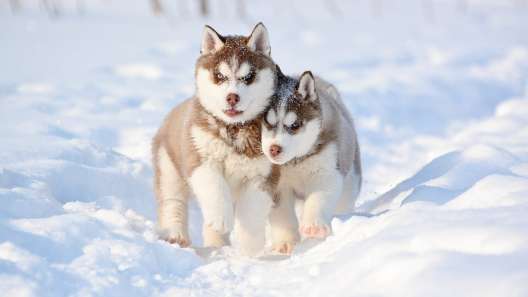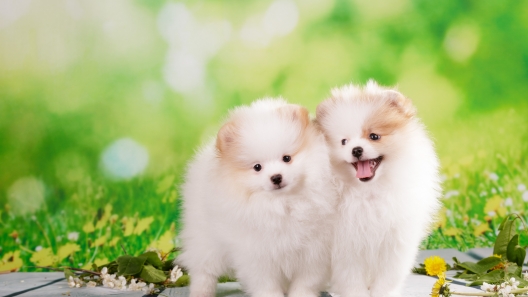
-
Activity Level:
high
-
Shedding Level:
high
-
Grooming Level:
high
-
Trainability:
moderate
-
Good for Novice Owners:
moderate
-
Adaptability:
high
-
Kid/Pet Friendly:
often
-
Prey Drive:
moderate
-
Watchdog:
very alert
- Average Size: Small
- Average Lifespan: 12-15 years
- Registered?: other
Pomsky Dog Breed Information
Overview
Temperament
Adaptability
Health
Owner Experience
Grooming
Activity Level
Size
Life Span
Did You Know?
The Pomsky, also sometimes called a Huskeranian, is a cross between a Siberian Husky and a Pomeranian. The goal of this cross is to capture the best traits of both breeds along with the beauty and personality of the Siberian Husky in a more manageable size.
For people who love Huskies and need a smaller dog, the Pomsky is often the perfect fit. Although the Pomsky is not currently recognized by the American Kennel Club, one of the facts about Pomskies is that they are recognized by other official organizations like the Pomsky Club of America, International Pomsky Association, and more.
Pomskies are known to be cute and adorable comedians. They are small, energetic dogs with big personalities and a zest for life. They tend to be sensitive, affectionate, and thrive on being the center of attention, which fits well with their silly and playful antics.
They get along well with children and other dogs, but tend to be a better fit for older children. Because a Pomsky is a small dog and an even smaller puppy, they can easily be injured by the accidental falls or rough play which can happen with younger children who are still mastering motor control. All interactions between young kids and puppies should be supervised.
Pomskies tend to make good watchdogs as they are alert and vocal. Both of their parent breeds are known to be quite vocal; Pomeranians for their barking and Siberian Huskies for their vocalizations. So, a Pomsky will let you know when they see something.
Because they can be so vocal, it’s important to start training your dog to stop barking early to keep it from becoming a nuisance when they are older. Socialization early and often is important for any dog breed and can also help curb alert barking with your Pomsky. Depending on the traits your Pomsky inherits, they could also end up with the high prey drive, urge to wander, and escape artist tendencies common to the Siberian Husky.
They tend to make good watchdogs as they are alert and vocal. Both of their parent breeds are known to be quite vocal, so a Pomsky will let you know when they see something. Because they are so vocal, it’s important to start training early as they can easily become yappy and bark too much. Socialization early and often is important for any dog breed and can also help with this tendency in your Pomsky. Depending on the traits your Pomsky inherits, they could get the high prey drive and urge to chase and wander common to the Siberian Husky.
A Pomsky is a highly adaptable dog breed. Although they are energetic, their small size makes them a good fit for apartments as well as larger homes with fenced yards. As long as they get enough daily exercise, mental stimulation, and attention, Pomskies can adapt to almost any living situation.
Pomskies also do well in most climates. As with any dog breed, they are sensitive to heat. Their thick cold makes them more tolerant of cold weather than many other dog breeds of a similar size. Because they thrive on attention and bond so closely with their families, they do not like to be left alone for long periods of time.
Although a mixed-breed dog can be healthier than a purebred dog, it’s not a guarantee. They could inherit the health conditions common to one, both, or neither of the parent breeds. Potential health conditions to be aware of in a Pomsky can include cataracts, Corneal Dystrophy, hip dysplasia, patellar luxation, and allergies.
Good breeding practices and the health of the parents make a big difference in the health of puppies. Reputable breeders will screen their dogs to avoid passing preventable issues to puppies. Make sure you ask about the health and genetic history of the parents. You can also ask about any health tests or clearances that have been done.
The Pomsky tends to be a moderately trainable dog. They are intelligent and pick up on things quickly, but they can inherit the stubborn streak common in Siberian Huskies. This, paired with their energy and getting bored easily, can be a challenge for first-time dog owners.
Novice dog owners considering a Pomsky are encouraged to be prepared to enroll in puppy training classes or to work with a dog trainer. Pomskies respond best to patient, consistent, and positive training techniques focused on rewards and praise.
Although a Pomsky can look like a miniature version of a Siberian Husky, they can also end up with the Pomeranian coat colors or a combination of both parent breed coat colors. Regardless, they will have a double coat and require a lot of grooming and maintenance. Both of the parent breeds are heavy shedders, so you should be prepared for the same in your Pomsky puppy.
You will want to brush your dog’s coat every day to remove loose fur, keep your dog comfortable, and help control shedding, especially during seasonal shedding. After all, if most of the loose fur is contained in dog grooming brushes, there is less of it all over your home.
In addition to coat care, you will also need to care for your Pomsky’s nails, ears, and teeth. Nail trims once or twice a month are usually enough to keep nails from getting too long and causing pain and discomfort. Checking your Pomsky’s ears weekly to ensure they are dry, clean, and free of debris, and carefully cleaning them as needed, can help prevent ear infections.
Proper dental care for dogs is also important in order to prevent painful dental diseases like gum disease and tooth decay. Using an enzyme toothpaste or brushing your dog’s teeth every day, along with cleanings at the vet as needed, is ideal for preventing the tartar and plaque buildup that leads to dental disease.
This is especially important for small dog breeds, like a Pomsky, as their small mouths tend to be more prone to dental-related issues, especially gum disease. You can also talk to your vet about supplementing your efforts with dental hygiene chews or even a specially-formulated “dental care diet”.
A Pomsky can range from moderate to high energy depending on which parent breed they take after more. Their Pomeranian parent sits in a more moderate range while their Siberian Husky parent is high energy and requires much more activity.
There is a chance a Pomsky will match their energy to yours, but as a new Pomsky parent, you will have to be prepared to handle whichever energy level your Pomsky puppy may have. In general, daily walks plus some playtime and extra activity will be sufficient for these dogs.
Once puppies finish growing, make sure to explore different activities with your Pomsky to discover the ones they enjoy most. Depending on your dog, they may enjoy jogging with you, going on hikes, taking trips to the dog park, or even going for a swim.
You could also try training them for dog sports like agility, flyball, obedience, and more. They may not be able to compete in official AKC competitions as a designer breed, but going through the training and activity could be something they enjoy.
A fully-grown Pomsky usually stands 10-15 inches tall and weighs 17-30 pounds. Although some people may think of the Pomsky as a toy breed, this should not be true, especially at the first-generation level.
Although there can be some variation in size, an F1 (first generation) Pomsky should be somewhere between 17 and 30 pounds; a small dog breed, but not a toy-sized breed. Even at the larger and heavier end of the spectrum, a Pomsky should not be over 40 pounds when fully grown.
Pomskies generally live for 12-15 years on average.
The first recorded litter of Pomsky puppies in the United States was in 2012.









